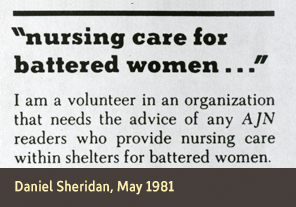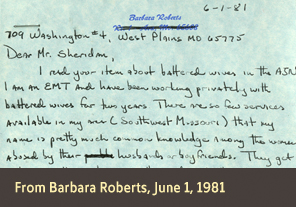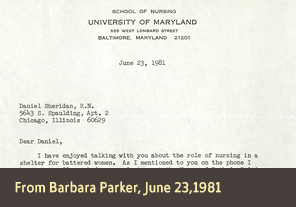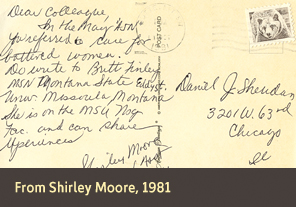Dear Mr. Sheridan
Read response letters to Daniel Sheridan's call for advice on nursing care in shelters
In 1981, nurse Daniel Sheridan wrote to the American Journal of Nursing, seeking advice from readers who might be providing nursing care in shelters for women who were battered. Within weeks, Sheridan received several letters from people around the United States. The letters highlighted here demonstrate how nurses and other concerned individuals were on the frontline of providing needed care for women, both in hospitals and shelters.
-

1. Daniel Sheridan, May 1981
Letter from Daniel Sheridan to the American Journal of Nursing, May 1981
The American Journal of Nursing published Daniel Sheridan's letter in its May 1981 issue. In his letter, Sheridan explained he was a volunteer at a women's advocacy organization on Chicago's southwest side, which was opening a shelter. He described his effort to establish daily nursing care at the shelter for women who had been battered and their children, and asked journal readers to share experiences with any similar endeavors.
-

2. From Barbara Roberts, June 1, 1981
Letter from Barbara Roberts to Daniel Sheridan, June 1, 1981
Barbara Roberts was an emergency medical technician in rural Missouri. She wrote Sheridan about her working privately with women experiencing domestic violence in her area, where there were few services for them. She described that "the attitude of local doctors and ED [emergency department] are that battered wives deserve what they get.$quot; Roberts informed Sheridan that she found no nursing and emergency care in shelters after having enquired about abused spouse programs previously.
-

3. From Meg Portwood, June 15, 1981
Letter from Meg Portwood to Daniel Sheridan, June 15, 1981
Meg Portwood, a family nurse practitioner, wrote to Sheridan about a shelter home she was involved with in Lincoln County, Oregon. She described the counseling services available to women who sought help from the shelter, and their families. She noted that women received nursing care in health care offices and not in the shelter, in order to keep the location of the shelter confidential. Portwood described that the shelter staff provided support for women to take charge of health care assessments for themselves and any children, "to maintain responsibility for all dimensions of her life."
-

4. From Barbara Parker, June 23,1981
Letter from Barbara Parker to Daniel Sheridan, June 23,1981
Barbara Parker-a nurse, assistant professor at the University of Maryland, and nurse supervisor at a shelter in Baltimore for women who were battered-responded to Daniel Sheridan. She described how nursing students provided care to women who sought help and their families, at the shelter in Baltimore. Parker noted that the students applied "the nursing process" to individuals and families experiencing a variety of stress states. Given the difficulty and complexity of working with families undergoing crises, Parker advised that only registered nurses or graduate students be placed in shelters.
-

5. From Jacquelyn Campbell, July 9, 1981
Letter from Jacquelyn Campbell to Daniel Sheridan, July 9, 1981
Jacquelyn Campbell wrote to Daniel Sheridan, drawing on her experiences as a nurse volunteer at a shelter in Detroit. She offered information on the types of medical and emotional issues typically seen with women and children in shelters; practical advice about coordination with other agencies and budgeting considerations; and a recommendation to ally with nursing programs at universities.
-

6. From Shirley Moore, 1981
Postcard from Shirley Moore to Daniel Sheridan, 1981
Shirley Moore from Butte, Montana sent Daniel Sheridan a postcard with the name of a member of the nursing faculty at Montana State University who could "share experiences" on nursing care for women who were battered.





![Handwritten letter <a href='/gallery/confrontingviolence/explore/dearmrsheridan/b/'>2. From Barbara Roberts, June 1, 1981</a><h5>Letter from Barbara Roberts to Daniel Sheridan, June 1, 1981</h5><p>Barbara Roberts was an emergency medical technician in rural Missouri. She wrote Sheridan about her working privately with women experiencing domestic violence in her area, where there were few services for them. She described that "the attitude of local doctors and ED [emergency department] are that battered wives deserve what they get.$quot; Roberts informed Sheridan that she found no nursing and emergency care in shelters after having enquired about abused spouse programs previously.</p>](http://www.nlm.nih.gov/exhibition/confrontingviolence/assets/thumbs/carousel-OB11012-small.jpg)





